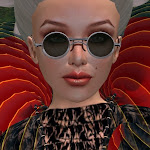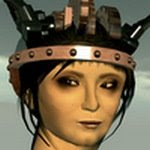Posted by Alpha Auer, with a very big thank you to the curator of Avatrait, Stephen Venkman who alerted us to the opening of Avatrait Island.
The new island of Avatrait was launched back at the end of November, so I am somewhat late in posting this piece. However, I wanted to give the matter some thought prior to doing so. I also co-authored a paper for an academic conference on virtual architecture in the interim, and that too has made me hold off and gather all of my thoughts on the subject. I also have to add a disclaimer here and state that I am not an architect but an artist/designer/Second Life® builder, so all of what I write on the subject is based upon mere gut instinct and a general knowledge of architectural concerns as far as they touch upon the basic design considerations common to all visual art and design practices.

What I saw at Avatrait is extremely well conceived, well designed, meticulously modeled and textured; tasteful, functional, user friendly Real Life architecture, which in many ways reminded me of the work of Eero Saarinen (particularly the convex white pavilion shown above), who is possibly my favorite architect of the 20th century. Thus, likening architectural output to Saarinen's is not a compliment I pay lightly and here I do so. Indeed I cannot find fault with the work and were these buildings to be found anywhere in Real Life they would doubtless be the pride of whichever municipality it was that they were constructed in. In fact so pristine are they, that they gave me a strong sense of being in a walkthrough presentation modeled in AutoCad, which a high caliber architectural firm had prepared for a high budget, high maintenance client. So the architects Corbett Howard and Prad Prathivi have done the project proud in many ways.
Then, why am I not completely won over? I believe the answer is already concealed in the word "Real Life" stated twice in the paragraph above. The fact that the structures are rezzed upon huge flipped sculpty rock cones may be an attempt at taking into account the affordances of the virtual, but it is not enough: I am of the tendency to believe that what constitutes the manifestation of the "virtual" in architecture has more to do with imagination than material. Thus, the sculpty rocks may not be possible in Real Life as such, however I suspect that the intention behind them is. While the peripheral pavilions have been rezed by Corbett Howard, the spheroid main exhibition hall is a build by Prad Prathivi - and it is particularly this central edifice that for me is problematic in terms of its virtual attributes. But all in all, none of these buildings seem to leave much to the imagination, do not carry concealed surprises, nothing about them is unexpected. They are very much what they are: Beautiful and functional constructs; built out of brick, mortar and marble, rezzed upon a mini archipelago of islets. The fact that the islands themselves are floating rocks is then neither here nor there.
...
Ouvroir, the Second Life annex of the Gestaltungsmuseum Zurich, dedicated to the work of Chris Marker, was built by MosMax Hax in the spring of 2008. Avatrait island has propelled me towards a comparative examination between Ouvroir and Avatrait: It is not only the fact that both sims are dedicated to the display of (predominantly 2 dimensional) art work or that at both places the central constructs are spherical, which are leading me to this comparison. Indeed it is not the similarities but the differences that seem to me to be decisive here: While Ouvroir is every bit as well conceived, well designed and well built as Avatrait Island (much to his credit Mr. Hax has refrained from using Real Life building textures, thereby greatly heightening the virtual "feel" of the construct); the huge addition that the artist/architect has managed to bring into his work at Ouvroir is the usage of the imaginative element as a design component, particularly in the navigation system of the building. 
While at Avatrait you walk up and down highly predictable staircases complete with banisters around the stairwell, at Ouvroir your only way of seeing the exhibit, which is spread out over a number of floors is by "falling down" to the next level through the designated phantom segments marked out in a semi transparent red. And to come back to the banisters at Avatrait: Why? Are the directors of Avatrait concerned about falling avatars creating liability issues? Health and safety regulations? Really, why?
While at Avatrait all that is there to see is plainly visible almost at first sight, Ouvroir is concealed, revealing itself bit by bit to its visitors. While Avatrait is complete as it is (I cannot for the life of me imagine how a single prim could be rezzed next to what is already there without becoming a major disruption of the whole system); Ouvroir allows for emergence and indeed seems to steadily be growing through the interventions of the members of its group who are continuously rezzing additions to the sim. And such is the mastery of the core red sphere which houses the actual Chris Marker collection at Ouvroir, that every addition seems to fit in, seems to be able to weave its way into the overall design tapestry. In short, while Avatrait is an endeavor to be admired respectfully and from a distance, Ouvroir invites you to be imaginative, to become involved and to play. Both are 3D, you can walk into both of them to an equal degree, but in a very bizarre kind of way Ouvroir is immersive while Avatrait remains aloof.
Keystone Bouchard needs to be taken very much to heart when he states that "architectural fabric created is still largely driven by very literal parallels to the physical world. This happens for good reason, as we have learned to visually organize the world around us, real or virtual, based on familiar cues and patterns. A roof may not need to protect us from the elements in virtual space, but it organizes a space. Even though you can fly, a ramp is still a strong way finding mechanism. While we import these visual cues from physical reality with good cause, I think we also need to consider the native, inherent characteristics of this environment and build a new language of virtual architecture based on those characteristics". Bouchard, is of course, referring to the dynamic element in virtual architecture in this text, to what he continues in the next line to describe as "virtual architecture has the capacity to become far more dynamic; behaving more like a liquid than a static and passive artifact".
I am going to do something quite improper here and use this quote out of the original context in which Bouchard has intended it. In other words, I will make it suit my own needs. Does a building need to be coded and dynamic to become virtual? Or is it more the underlying intention of usage, the very spirit in which it has been conceived of that really makes the difference between what is possible and not possible in Real Life? 
Emergent interventions at Ouvroir: This infovis-like structure featuring a selection of photographs by Chris Marker was rezed in close proximity to the red sphere by Ouvroir group member Lucien Bookmite. Photograph courtesy of Barbara Binder.
Both buildings make usage of Real Life architectural metaphor, such as floors and ceilings and ramps, for the purposes of way finding. And as a construct Ouvroir is as static as Avatrait is. And yet as far as I can see, there is a huge difference and to me that difference lies in the ultimate approach of the architect, the spirit in which the whole enterprise has been undertaken: The one that emphasizes imagination and play over realism. Involvement over spectatorship. Intervention over consumption. Making a noteworthy immersive virtual experience out of Ouvroir and a beautiful receptacle for art work out of Avatrait Island. Thus, to each his due...
You can teleport to Avatrait Island from here, and to Ouvroir from here. You can see a collection of larger sized photographs of Ouvroir here and Avatrait Island here.
Friday, December 12, 2008
Exhibiting Art in Virtual Spaces
Posted by
Alpha Auer
at
1:00 AM
![]()
Labels: architecture, Avatrait, Barbara Binder, Chris Marker, Corbett Howard, Eero Saarinen, Keystone Bouchard, Lucien Bookmite, Max Moswitzer, MosMax Hax, Ouvroir, Prad Prathivi, Second Life, Stephen Venkman







3 comments:
Its always wonderful getting the ideas and thoughts of others on what one creates. I find it both a learning experience and most humbling. I wanted to thank you Alpha for taking the time to look about the SIM and then setting down your well thought out critique here. I for one, will take what you've written down and consider it as I move forward and continue to add to the Avatrait SIM as well as any future projects.
I also wanted to take the opportunity to thank Prad for being a wonderful build partner. Lord knows he had to point out a few of my own mistakes along the way!! :)
I look forward to completing this SIM. Bit by bit. It will obviously grow with the contributions of many others to come. Be filled with not only the 2D art but 3D sculpture and Machinima. Alive with the sounds of classes to help those to improve their art. And while its not Impossible in Real Life, It is for me at least one more step in my SL journey to see just what is possible for me :)
Corbett, Thank you so much for your truly gracious response. I should tell you again, that I really liked what you guys created over there - and especially yours. I felt bad about not being able to put images of the little meeting room with all the floating pennants that you designed. I think that is one of the most graceful constructs I have ever seen in SL - or RL for that matter...
These critiques ultimately boil down to a personal viewpoint, mine being quite strongly embodied at Syncretia , my island, which I hope you will visit before too long. Please let me know ahead of time if/when you would like to come over so that we can meet and I can personally give you the grand tour - so to speak.
And also, I am very curious about this: You are an architect in RL as well, yes? I would love to see photos of your work there as well.
Alpha and Corbett, I so appreciate this kind of discourse and understand the tension between rl/vw. As vw's evolve the concomitant design grammars will too. We're still in an additive phase, much like early cinema, where artists applied the grammar of the traditional medium, still photography, to the new medium. The expressive phase, where new grammars are developed through the new media, is just now beginning.
If there are any useful parallels here to rl, they're most certainly in the art world itself: Accessible, massified art forms always overshadow those on the edges, those that are intelligent, insightful, skilled and innovative.
This began with the industrial revolution in the 19th century and is still steaming along.
What's disheartening in the U.S. is that our relationship to art as a mass commodity has been all this time failing to develop educated audiences. Now, we no longer even provide art education (art appreciation) in schools and worse yet, the ubiquity of easy to use new-media tools situates anyone in the role of "artist."
Post a Comment